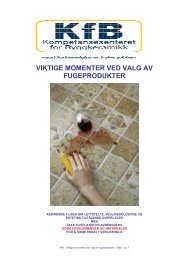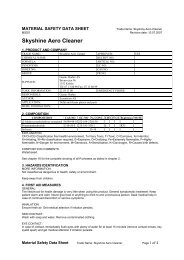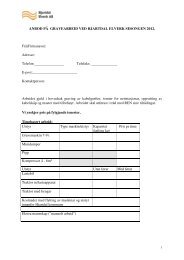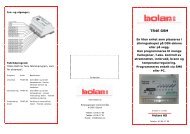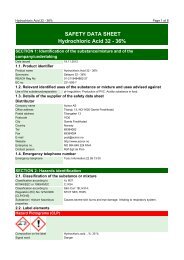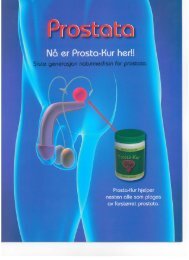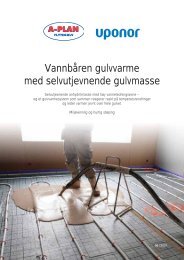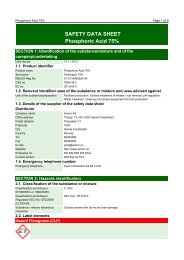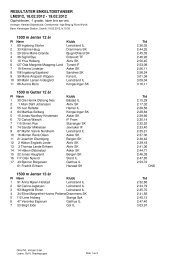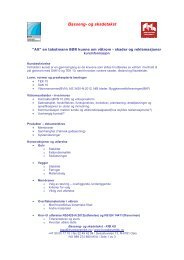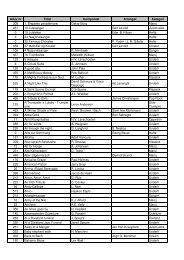SAFETY DATA SHEET Caustic Soda 50%
SAFETY DATA SHEET Caustic Soda 50%
SAFETY DATA SHEET Caustic Soda 50%
Create successful ePaper yourself
Turn your PDF publications into a flip-book with our unique Google optimized e-Paper software.
<strong>Caustic</strong> <strong>Soda</strong> <strong>50%</strong> Page 1 of 8<br />
<strong>SAFETY</strong> <strong>DATA</strong> <strong>SHEET</strong><br />
<strong>Caustic</strong> <strong>Soda</strong> <strong>50%</strong><br />
SECTION 1: Identification of the substance/mixture and of the<br />
company/undertaking<br />
Date issued 12.11.2012<br />
1.1. Product identifier<br />
Product name <strong>Caustic</strong> <strong>Soda</strong> <strong>50%</strong><br />
Synonyms Natronlut <strong>50%</strong><br />
REACH Reg No 01-2119457892-27<br />
CAS no. 1310-73-2<br />
EC no. 215-185-5<br />
1.2. Relevant identified uses of the substance or mixture and uses advised against<br />
Use of the substance/preparation pH regulation. Production of alkaline soap. Refining of oils.<br />
1.3. Details of the supplier of the safety data sheet<br />
Distributor<br />
Company name<br />
Office address<br />
Acinor AS<br />
Titangt. 13, NO-1630 Gamle Fredrikstad<br />
Postal address Titangaten 13<br />
Postcode 1630<br />
City<br />
Gamle Fredrikstad<br />
Country<br />
Norway<br />
Tel 69384082<br />
Fax 69384084<br />
E-mail<br />
post@acinor.no<br />
Website<br />
http://www.acinor.no<br />
Enterprise no.<br />
NO 984 648 324 MVA<br />
Contact person<br />
Rolf Egil de Flon<br />
1.4. Emergency telephone number<br />
Emergency telephone Toxic Information:22 59 13 00<br />
SECTION 2: Hazards identification<br />
2.1. Classification of the substance or mixture<br />
Classification according to<br />
67/548/EEC or 1999/45/EC<br />
Classification according to<br />
Regulation (EC) No 1272/2008<br />
[CLP/GHS]<br />
Substance / mixture hazardous<br />
properties<br />
2.2. Label elements<br />
Hazard Pictograms (CLP)<br />
C; R35<br />
Skin Corr 1A; H314;<br />
Causes severe skin burns and eye damage.<br />
Composition on the label Sodium hydroxide: 5 - 55 %
<strong>Caustic</strong> <strong>Soda</strong> <strong>50%</strong> Page 2 of 8<br />
Signal word<br />
Hazard statements<br />
Precautionary statements<br />
2.3. Other hazards<br />
PBT / vPvB<br />
Danger<br />
H314 Causes Severe skin burns and eye damage.<br />
P101 If medical advice is needed, have product container or label at hand.<br />
P273 Avoid release to the environment.<br />
P280 Wear protective gloves/protective clothing/eye protection/face protection.<br />
P305 + P351 + P338 IF IN EYES: Rinse cautiously with water for several<br />
minutes. Remove contact lenses, if present and easy to do. Continue rinsing.<br />
PBT/vPvB assessment has not been performed.<br />
SECTION 3: Composition/information on ingredients<br />
3.1. Substances<br />
Component name Identification Classification Contents<br />
Water CAS no.: 7732-18-5<br />
EC no.: 231-791-2<br />
Sodium hydroxide CAS no.: 1310-73-2<br />
EC no.: 215-185-5<br />
Index no.: 011-002-00-6<br />
Synonyms: Sodium hydroxide<br />
Component comments<br />
C; R35<br />
Skin Corr. 1A; H314<br />
See section 16 for explanation of H- and R-phrases listed above.<br />
SECTION 4: First aid measures<br />
4.1. Description of first aid measures<br />
General<br />
If in doubt, seek medical advice.<br />
Inhalation<br />
Skin contact<br />
Eye contact<br />
Ingestion<br />
45 - 95 %<br />
5 - 55 %<br />
Fresh air and rest. Get medical attention if any discomfort continues. For<br />
breathing difficulties oxygen may be necessary. Perform artificial respiration if<br />
breathing has stopped. Get medical attention.<br />
Remove contaminated clothing. Wash the skin immediately with soap and<br />
water. Important to remove the substance from the skin immediately. Get<br />
medical attention. Chemical burns must be treated by a physician. Wash<br />
contaminated clothes befor reuse.<br />
Promptly rinse eyes with plenty of water (tempered at 20-30°C) for at least<br />
15 minutes. Remove contact lenses and open eyes wide apart. Immediately<br />
consult a doctor. Immediately transport to hospital or eye specialist. Continue<br />
flushing during transport to hospital.<br />
DO NOT INDUCE VOMITING! Rinse mouth thoroughly with water and give<br />
large amounts of milk or water to people not unconscious. Immediately<br />
consult a doctor. Risk of perforation of esophagus and stomach. Transport to<br />
hospital. Bring the safety data sheet.<br />
4.2. Most important symptoms and effects, both acute and delayed<br />
Information for health personnel Treat Symptomatically. Treated as burn injuries.<br />
Acute symptoms and effects<br />
Is highly corrosive and can cause severe pain.<br />
Skin contact: Cause blisters and burns.<br />
Corrosive to the eyes, danger of vision impairment / blindness, burning nose,<br />
chemical burns to the skin.<br />
Causes burns if swallowed. Causes burning sensation in the mouth, throat<br />
and esophagus. May cause serious permanent damage.<br />
Inhalation of product may cause irritation, high levels can cause difficulty in<br />
breathing and possible lung damage.<br />
Inhalation of high concentrations of this product may cause the same<br />
symptoms if swallowed.<br />
4.3. Indication of any immediate medical attention and special treatment needed<br />
Other Information No specific treatment required, see section 4.1.
<strong>Caustic</strong> <strong>Soda</strong> <strong>50%</strong> Page 3 of 8<br />
SECTION 5: Firefighting measures<br />
5.1. Extinguishing media<br />
Suitable extinguishing media<br />
Improper extinguishing media<br />
Use fire-extinguishing media appropriate for surrounding materials.<br />
Do not use water jet.<br />
5.2. Special hazards arising from the substance or mixture<br />
Fire and explosion hazards<br />
The product is not classified as flammable.<br />
Hazardous combustion products Explosive gases/vapors/fumes.<br />
5.3. Advice for firefighters<br />
Personal protective equipment<br />
Other Information<br />
Use fresh air equipment when the product is involved in fire. In case of<br />
evacuation, an approved protection mask should be used. See also section 8.<br />
Containers close to fire should be removed immediately or cooled with water.<br />
Extinguishing water must not be discharged into drains.<br />
SECTION 6: Accidental release measures<br />
6.1. Personal precautions, protective equipment and emergency procedures<br />
Personal precautions Use protective equipment as referred to in section 8.<br />
Avoid inhalation of vapours and contact with skin and eyes. Look out! The<br />
product is corrosive.<br />
6.2. Environmental precautions<br />
Environmental precautions<br />
Do not allow to enter into sewer, water system or soil.<br />
6.3. Methods and material for containment and cleaning up<br />
Methods for cleaning<br />
Cleaning up<br />
6.4. Reference to other sections<br />
Other instructions See also sections 8 and 13.<br />
SECTION 7: Handling and storage<br />
7.1. Precautions for safe handling<br />
Handling<br />
Absorb in vermiculite, dry sand or earth and place into containers. Collect in<br />
a suitable container and dispose as hazardous waste according to section 13.<br />
Limit spread of spilled material.<br />
Small amounts could be picked up using moist disposable cloth.<br />
Wash the contaminated surface with water.<br />
Use protective equipment as referred to in section 8. Provide adequate<br />
ventilation.<br />
Avoid direct contact. Avoid inhalation of vapours. Avoid spilling, skin and eye<br />
contact. Change contaminated clothing.<br />
Use work methods which minimise aerosol production.<br />
Never add water directly to this product - may cause vigorous reaction/boiling.<br />
Always dilute by carefully pouring the product into the water.<br />
Protective Measures<br />
Advice on general occupational<br />
hygiene<br />
7.2. Conditions for safe storage, including any incompatibilities<br />
Storage<br />
Requirements for storage rooms<br />
and vessels<br />
Hints on storage assembly<br />
7.3. Specific end use(s)<br />
Specific use(s) See section 1.2.<br />
Wash hands at the end of each work shift and before eating, smoking and<br />
using the toilet. Do not eat, drink or smoke during work.<br />
Store dry and cool in a well ventilated area. Store in tightly closed container.<br />
Store protected from light and direct sunlight. Corrosive storage.<br />
Suitable containers: Acid resistant steel.<br />
Unsuitable containers: aluminium. Zinc. Lead. Tin.<br />
Keep away from: Acids. Water, steam, water mixtures.<br />
SECTION 8: Exposure controls/personal protection
<strong>Caustic</strong> <strong>Soda</strong> <strong>50%</strong> Page 4 of 8<br />
8.1. Control parameters<br />
Other Information about threshold CAS-nr.:1310-73-2 has got note T = maximum value.<br />
limit values<br />
Exposure limit values<br />
Component name Identification Value Year<br />
Sodium hydroxide CAS no.: 1310-73-2<br />
EC no.: 215-185-5<br />
Index no.: 011-002-00-6<br />
Synonyms: Sodium hydroxide<br />
8.2. Exposure controls<br />
Occupational exposure controls<br />
Respiratory protection<br />
Respiratory protection<br />
Hand protection<br />
Hand protection<br />
Necessary hand protection<br />
properties<br />
Suitable materials<br />
Breakthrough time<br />
Eye / face protection<br />
Eye protection<br />
Skin protection<br />
Skin protection (other than of the<br />
hands)<br />
Additional skin protection measures<br />
Other Information<br />
Other Information<br />
15 min.: 2 mg/m3 2011<br />
Personal protection equipment should be chosen according to the CEN<br />
standards and in discussion with the supplier of the personal protective<br />
equipment. Provide adequate ventilation, including appropriate local extraction,<br />
to ensure that the defined occupational exposure limit is not exceeded.<br />
In case of inadequate ventilation or risk of inhalation of vapours, use suitable<br />
respiratory equipment with combination filter (type B2/P2). Wear air-supplied<br />
mask in confined areas.<br />
Use chemical resistant gloves.<br />
Use gloves with long sleeves.<br />
Nitrile. Butyl rubber. Polyvinyl chloride (PVC). Neoprene. 4H multilayered<br />
gloves.<br />
Penetration time is not known. The recommended material of gloves is<br />
recommended after a study of the single components in the product.<br />
Use safety goggles or face shield in case of splash risk.<br />
Wear appropriate protective clothing to protect against possible skin contact.<br />
Wash promptly if skin becomes wet or contaminated. Promptly remove any<br />
clothing that becomes wet or contaminated.<br />
The listed protective equipment is a recommendation. A risk assessment of<br />
the actual risk may lead to other requirements.<br />
Eye wash facilities and emergency shower should be available when handling<br />
this product.<br />
SECTION 9: Physical and chemical properties<br />
9.1. Information on basic physical and chemical properties<br />
Physical state<br />
Fluid.<br />
Colour<br />
Colourless.<br />
Odour<br />
No characteristic odour.<br />
Comments, Odour limit<br />
Not known.<br />
pH (as supplied) Value: > 14<br />
Comments, pH (as supplied) Concentrated solution.<br />
Comments, Melting point / melting Not known.<br />
range<br />
Boiling point / boiling range Value: ~ 145 °C<br />
Comments, Flash point<br />
Not known.<br />
Comments, Evaporation rate Not known.<br />
Flammability (solid, gas)<br />
Not known.
<strong>Caustic</strong> <strong>Soda</strong> <strong>50%</strong> Page 5 of 8<br />
Comments, Explosion limit<br />
Vapour pressure<br />
Comments, Vapour density<br />
Specific gravity Value: 1,63<br />
Solubility in water<br />
Soluble.<br />
Comments, Partition coefficient: n- Not known.<br />
octanol / water<br />
Comments, Spontaneous<br />
Not known.<br />
combustability<br />
Comments, Decomposition<br />
Not known.<br />
temperature<br />
Comments, Viscosity<br />
Not known.<br />
Physical hazards<br />
Explosive properties<br />
Oxidising properties<br />
Not known.<br />
Value: 0,4 kPa<br />
Test temperature: 40 °C<br />
Not known.<br />
Not known.<br />
Not known.<br />
9.2. Other information<br />
Other physical and chemical properties<br />
Physical and chemical properties Freezing point: -12 °C.<br />
SECTION 10: Stability and reactivity<br />
10.1. Reactivity<br />
Reactivity<br />
Data lacking.<br />
10.2. Chemical stability<br />
Stability<br />
10.3. Possibility of hazardous reactions<br />
Possibility of hazardous reactions<br />
Stable under normal temperature conditions and recommended use. The<br />
substance is hygroscopic and will absorb water by contact with the moisture<br />
in the air.<br />
Arise in contact with incompatible materials (section 10.5) and inappropriate<br />
conditions (section 10.4).<br />
Corrosive to some metals as zinc and aluminium, evolving hydrogen gas that<br />
may form explosive mixtures with air.<br />
10.4. Conditions to avoid<br />
Conditions to avoid<br />
Moisture.<br />
10.5. Incompatible materials<br />
Materials to avoid<br />
Acids. Water, steam, water mixtures. Aluminium. Lead. Zinc. Tin.<br />
10.6. Hazardous decomposition products<br />
Hazardous decomposition products None under normal conditions. See also section 5.2.<br />
SECTION 11: Toxicological information<br />
11.1. Information on toxicological effects<br />
Toxicological Information:<br />
LD50 oral<br />
LD50 dermal<br />
Value: > 500 mg/kg<br />
Test animal species: Rabbit<br />
Comments: 25% solution.<br />
Value: 1350 mg/kg<br />
Test animal species: Rabbit<br />
Other information regarding health hazards<br />
General<br />
Potential acute effects<br />
Causes severe burns. Prolonged exposure to this chemical may cause<br />
permanent damage.
<strong>Caustic</strong> <strong>Soda</strong> <strong>50%</strong> Page 6 of 8<br />
Inhalation<br />
Skin contact<br />
Eye contact<br />
Ingestion<br />
Delay / Repeating<br />
Sensitisation<br />
Carcinogenic, Mutagenic or Reprotoxic<br />
Carcinogenicity<br />
Mutagenicity<br />
Teratogenic properties<br />
Reproductive toxicity<br />
Symptoms of Exposure<br />
Other Information<br />
SECTION 12: Ecological information<br />
12.1. Toxicity<br />
Acute aquatic, fish<br />
Acute aquatic, fish, Comments<br />
Acute aquatic, Daphnia<br />
Ecotoxicity<br />
12.2. Persistence and degradability<br />
Persistence and degradability<br />
Highly Corrosive. Vapours are corrosive. After 24-36 hours, injured persons<br />
may develop serious shortness of breath and lung oedema. High<br />
concentrations may cause severe lung damage.<br />
Causes severe burns. May cause serious chemical burns to the skin. Cause<br />
blisters and burns.<br />
Strongly corrosive. Causes severe burns and serious eye damage. Immediate<br />
first aid is imperative. Risk of permanent corneal damage, loss of sight and<br />
blindness.<br />
Causes burns if swallowed. Causes burning sensation in the mouth, throat<br />
and esophagus. May cause serious permanent damage.<br />
None of the substances mentioned in section 3 is considered to have<br />
sensitizing effects according to current labelling rules.<br />
None of the substances mentioned in section 3 is considered as carcinogenic<br />
according to current labelling rules.<br />
None of the substances mentioned in section 3 are considered to have<br />
mutagenic or pro-mutagenic effects.<br />
None of the substances mentioned in section 3 are considered to cause harm<br />
to the unborn child.<br />
None of the substances mentioned in section 3 are considered to have<br />
genotoxic effects.<br />
In case of eyedamage, continue to flush with water all the way to the doctor.<br />
Chemical burns to skin may be treated as fire caused wounds. Splash in eye<br />
requires examination by eye specialist.<br />
Value: 180 mg/l<br />
Method of testing: LC50<br />
Fish, species: Carp<br />
Duration: 24 hours<br />
Value: 125 mg/l<br />
Method of testing: LC50<br />
Fish, species: Mosquito fish<br />
Duration: 96 hours<br />
Value: 99 mg/l<br />
Method of testing: LC50<br />
Fish, species: Bluegill<br />
Duration: 48 hours<br />
Value: 30 mg/l<br />
Method of testing: EC50<br />
Duration: 48 hours<br />
The product components are not classified as environmentally hazardous.<br />
However, this does not exclude the possibility that large or frequent spills can<br />
have a harmful or damaging effect on the environment.<br />
The product may affect the acidity (pH-factor) in water with risk of harmful<br />
effects to aquatic organisms.<br />
The necessity of neutralization has to be evaluated.<br />
The product consists mainly of inorganic materials which are not<br />
biodegradable.
<strong>Caustic</strong> <strong>Soda</strong> <strong>50%</strong> Page 7 of 8<br />
12.3. Bioaccumulative potential<br />
Bioaccumulative potential<br />
Not expected to bioaccumulate.<br />
12.4. Mobility in soil<br />
Mobility<br />
Soluble in water.<br />
12.5. Results of PBT and vPvB assessment<br />
PBT assessment results<br />
PBT assessment has not been performed.<br />
vPvB evaluation results<br />
vPvB assessment has not been performed.<br />
12.6. Other adverse effects<br />
Other adverse effects / Remarks<br />
SECTION 13: Disposal considerations<br />
13.1. Waste treatment methods<br />
Specify the appropriate methods of<br />
disposal<br />
Product classified as hazardous<br />
waste<br />
EWC waste code<br />
NORSAS<br />
Alkalies cause increased pH values in the water. A high pH value harms<br />
aquatic organisms. Do not allow to enter into sewer, water system or soil.<br />
Disposed of as hazardous waste by approved contractor. The waste code<br />
(EWC-Code) is intented as a guide. The code must be chosen by the user,<br />
if the use differs from the one mentioned above.<br />
Yes<br />
EWC: *06 02 04 sodium and potassium hydroxide<br />
7132 Bases, unorganic.<br />
SECTION 14: Transport information<br />
14.1. UN number<br />
ADR 1824<br />
RID 1824<br />
IMDG 1824<br />
ICAO/IATA 1824<br />
14.2. UN proper shipping name<br />
ADR<br />
SODIUM HYDROXIDE SOLUTION<br />
RID<br />
SODIUM HYDROXIDE SOLUTION<br />
IMDG<br />
SODIUM HYDROXIDE SOLUTION<br />
ICAO/IATA<br />
SODIUM HYDROXIDE SOLUTION<br />
14.3. Transport hazard class(es)<br />
ADR 8<br />
Hazard no. 80<br />
RID 8<br />
IMDG 8<br />
ICAO/IATA 8<br />
14.4. Packing group<br />
ADR<br />
II<br />
RID<br />
IMDG<br />
ICAO/IATA<br />
II<br />
II<br />
II<br />
14.5. Environmental hazards<br />
IMDG Marine pollutant<br />
No<br />
14.6. Special precautions for user<br />
EmS<br />
F-A, S-B<br />
14.7. Transport in bulk according to Annex II of MARPOL 73/78 and the IBC Code<br />
Other applicable information.<br />
Other applicable information. Not applicable.
<strong>Caustic</strong> <strong>Soda</strong> <strong>50%</strong> Page 8 of 8<br />
SECTION 15: Regulatory information<br />
EC no. 215-185-5<br />
15.1. Safety, health and environmental regulations/legislation specific for the<br />
substance or mixture<br />
References (laws/regulations)<br />
15.2. Chemical safety assessment<br />
Chemical safety assessment has<br />
been carried out<br />
Norwegian regulation on classification and labeling of dangerous chemicals.<br />
Valid from June 21, 2010.<br />
Regulation on classification, labeling and packaging of substances and<br />
mixtures (CLP) dated 16.06.2012.<br />
Commission Regulation (EU) No 453/2010 amending Regulation (EC) No<br />
1907/2006 of the European Parliament and of the Council on the Registration,<br />
Evaluation, Authorisation and Restriction of Chemicals (REACH), Annex II<br />
Safety Data Sheets.<br />
Administrative norms for pollution of the atmosphere, the latest edition, from<br />
Norwegian labour inspection authority<br />
Norwegian regulations on waste, no. 930/2004, from Minestry of the<br />
Environment.<br />
Dangerous Goods regulations<br />
The Safety Data Sheet is based on information provided by the producer.<br />
No<br />
SECTION 16: Other information<br />
Supplier's notes<br />
Classification according to<br />
Regulation (EC) No 1272/2008<br />
[CLP/GHS]<br />
List of relevant R phrases (under<br />
headings 2 and 3).<br />
List of relevant H-phrases (Section<br />
2 and 3).<br />
Abbreviations and acronyms used<br />
Sources of key data used to<br />
compile the safety data sheet<br />
Information which has been added,<br />
deleted or revised<br />
Checking quality of information<br />
Responsible for safety data sheet<br />
Prepared by<br />
The information contained in this SDS must be made available to all those<br />
who handle the product.<br />
Skin Corr 1A; H314;<br />
R35 Causes severe burns.<br />
H314 Causes Severe skin burns and eye damage.<br />
PBT: Persistent, Bioaccumulative and Toxic<br />
vPvB: very Persistent and very Bioaccumulative<br />
Version: 3 from supplier dated: 16.12.2010<br />
New Safety Data Sheet.<br />
This SDS is quality controlled by National Institute of Technology in Norway,<br />
certified according to the Quality Management System requirements specified<br />
in ISO 9001:2008.<br />
Acinor AS<br />
National Institute of Technology as, Norway v/ Camilla M. Ormset




